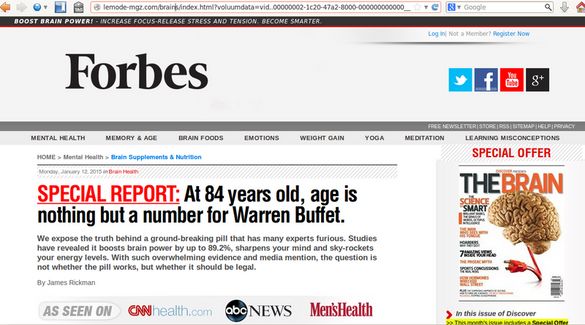How 1000 Google employees blocked 780 million ads in 2015
In 2014, Google blocked 500 million ads , in 2015 - already 780 million. More than a thousand employees are already struggling with bad advertising in browsers and in applications.

In the summer of 2014, Google experts noticed advertisements with non-existing holiday homes. The links did not have any malicious software - they were simply unrealistic at home, their images were obtained from photo stocks, and the purpose of the scammers was to deposit money from “clients”. Another common scam in the year before last was the sale of drugs for the Ebola virus.
Ad networks have become a popular way to distribute malicious software. In early 2015, criminals changed the Google AdSense banner ads in such a way that they redirected users to fraudulent sites similar to real magazine sites - for example, Forbes. Then two AdWords campaigns suffered.
')

Fake Forbes site
Google employees in 2015 blocked 780 million different ads. It was an ad, misleading users, selling non-existent or counterfeit products, sending users to phishing sites or to sites with viruses. A huge number of ads require automation of processes, and Google uses various algorithms to search for offenders.
But there are not enough programs - we need real people who look at questionable ads. Sridhar Ramaswami, head of advertising and commerce at Google, said that the company has hired more than a thousand people whose task is to fight bad advertising. This helps the company to get rid of most of the scam ads before anyone sees their ads.
Google struggled with advertising products for weight loss, counterfeit goods, advertising drugs, as well as the similarity of the system notifications "Your computer is infected, urgently install this antivirus." Drug advertising served Google as a disservice in 2011, when the company paid a $ 500 million fine to US authorities for revenue received from Canadian pharmaceutical manufacturers.
A separate topic - ads in applications on Google Play. Here, too, along with the algorithms live employees work. Google has stopped showing ads in 25,000 mobile applications due to policy inconsistencies, a third of them were blocked because ads were too close to the application buttons, which caused random clicks. 1.4 million applications have been removed from Google Play.

In the summer of 2014, Google experts noticed advertisements with non-existing holiday homes. The links did not have any malicious software - they were simply unrealistic at home, their images were obtained from photo stocks, and the purpose of the scammers was to deposit money from “clients”. Another common scam in the year before last was the sale of drugs for the Ebola virus.
Ad networks have become a popular way to distribute malicious software. In early 2015, criminals changed the Google AdSense banner ads in such a way that they redirected users to fraudulent sites similar to real magazine sites - for example, Forbes. Then two AdWords campaigns suffered.
')

Fake Forbes site
Google employees in 2015 blocked 780 million different ads. It was an ad, misleading users, selling non-existent or counterfeit products, sending users to phishing sites or to sites with viruses. A huge number of ads require automation of processes, and Google uses various algorithms to search for offenders.
But there are not enough programs - we need real people who look at questionable ads. Sridhar Ramaswami, head of advertising and commerce at Google, said that the company has hired more than a thousand people whose task is to fight bad advertising. This helps the company to get rid of most of the scam ads before anyone sees their ads.
Google struggled with advertising products for weight loss, counterfeit goods, advertising drugs, as well as the similarity of the system notifications "Your computer is infected, urgently install this antivirus." Drug advertising served Google as a disservice in 2011, when the company paid a $ 500 million fine to US authorities for revenue received from Canadian pharmaceutical manufacturers.
A separate topic - ads in applications on Google Play. Here, too, along with the algorithms live employees work. Google has stopped showing ads in 25,000 mobile applications due to policy inconsistencies, a third of them were blocked because ads were too close to the application buttons, which caused random clicks. 1.4 million applications have been removed from Google Play.
Source: https://habr.com/ru/post/298110/
All Articles